Marigolds (Latin - Tagetes, on behalf of the grandson of Jupiter) symbolizes longevity in many countries. The plant is often called Sweet William or Marigolds. These flowers are one of the versatile annuals, without which it is impossible to imagine any landscaping or garden, or cottage. On the territory of Russia are growing everywhere except the Far North. Homeland - America, where they are now found in the wild-growing form. Elegant and bright, uplifting spectacular beds of marigold buds decorative delight the eye throughout the summer season.
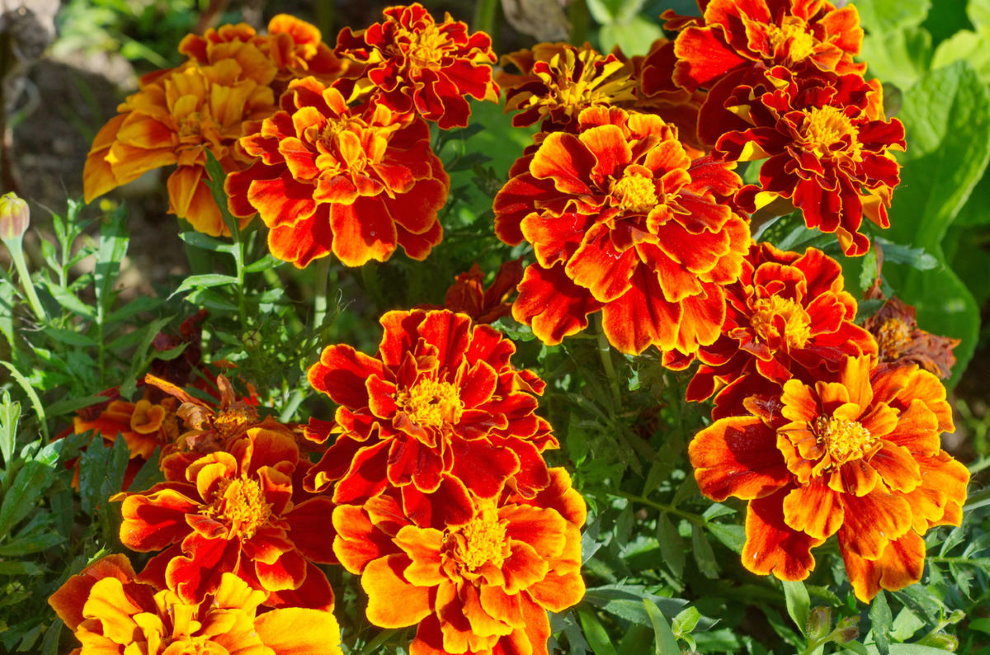
Due to its unpretentiousness and high decorative marigolds enjoy an enviable popularity among gardeners
Description of colors
Content
- Description of colors
- The main varieties
- Using marigold in landscape design
- The combination of marigold with other colors
- Tips and advice on registration of landscape design
- Video: Review of the best varieties of marigold
- Photo Gallery: Marigold in the garden
Stems plant belonging to the Compositae family, upright habit or branched, a height of 20 to 130 cm, with a fibrous root system. Leaves - from light to dark green, pinnatipartite, with well looked structural veins, arts decorated on the edge of the teeth. Baskets in different colors: yellow, orange, brown - have a diameter of 4-6 cm, velvety in appearance, often a two- or three-colored.
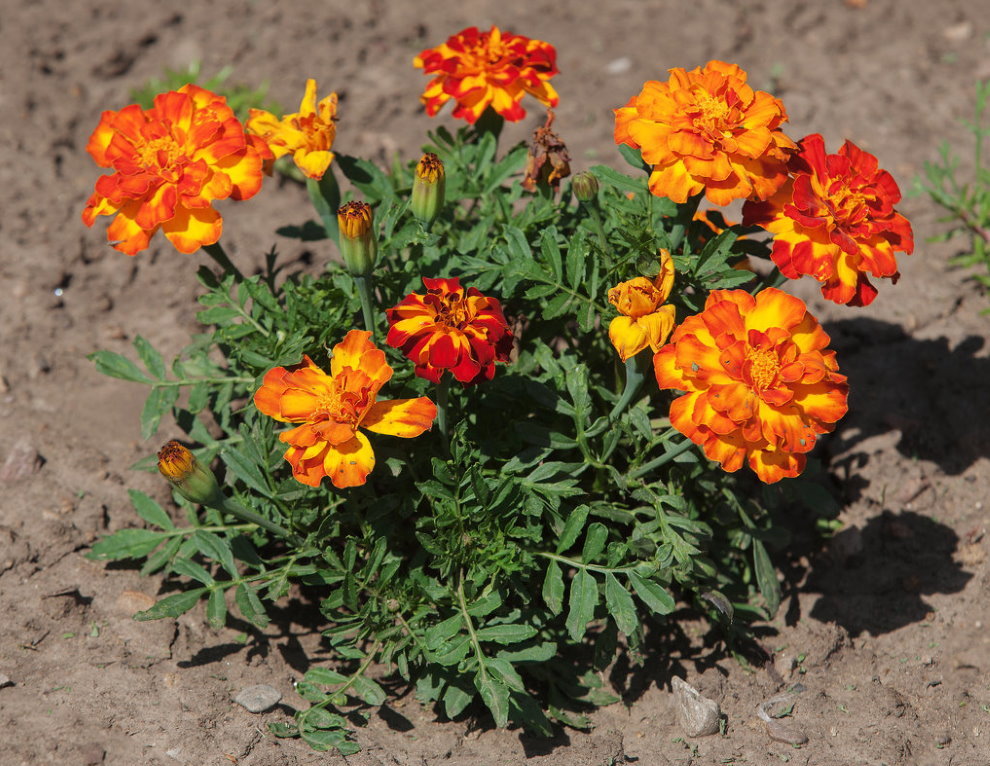
Tagetes - representative annual plants with a sufficiently strong root system and aerial part branched
Marigolds on the flowerbed in the photo, in perfect harmony with the landscape design, look great over a long period-June until frost. The seeds germinate and give self-seeding for 3-4 years. His spicy scent tagetesy owe more foliage - it smells stronger than buds.
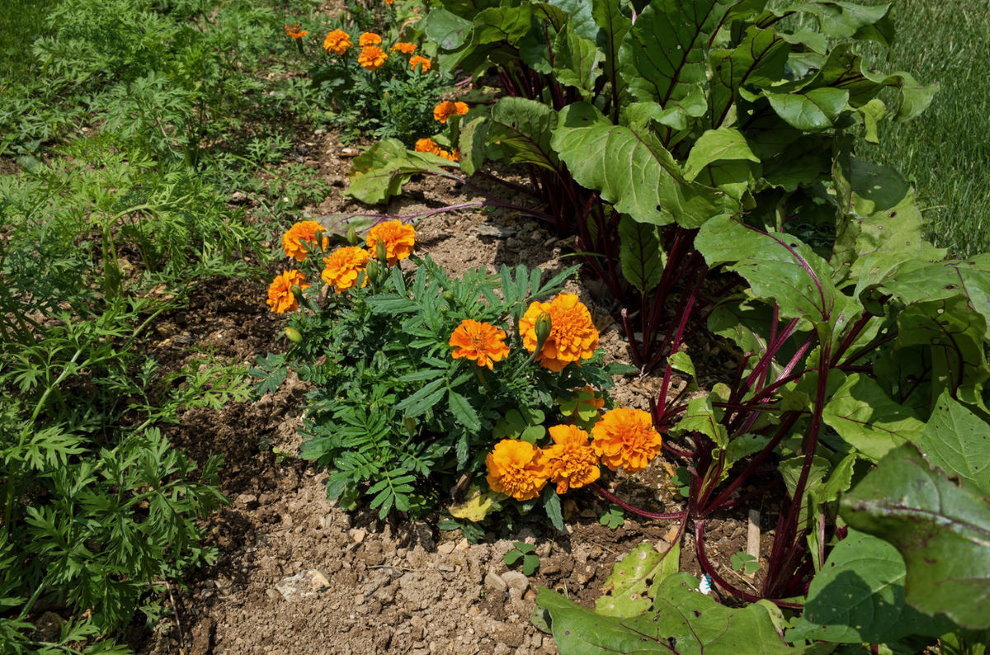
The specific aroma of marigold deters pests, so the bushes with orange flowers can often be seen among the garden beds
The plant was used by the Indians in medicine and cooking, and now it is widely used in cosmetics in the manufacture of masks for the face and hair conditioners. Of the petals, leaves and buds of some types of flowers often get the seasoning to be added to salads, first courses, meat.

Marigold flowers have long been featured in popular recipes from various illnesses
The main varieties
Classification marigold produced in several ways.
The height of the bush (in cm):
- Giant - 90-120. Used as filling the background or as a border beds landscape design.
- High - 60-90. The functional purpose of the plant - is the same.
- Medium - 45-60. They are planting the middle of the flower beds mixborders or monoculture.
- Low - 25-45. Used for planting on the edges of the track, as well as fill the voids near the single-flower perennials.
- Dwarf - 20. Often used in the mini-beds, or as an element of landscape design in the form of carpet.
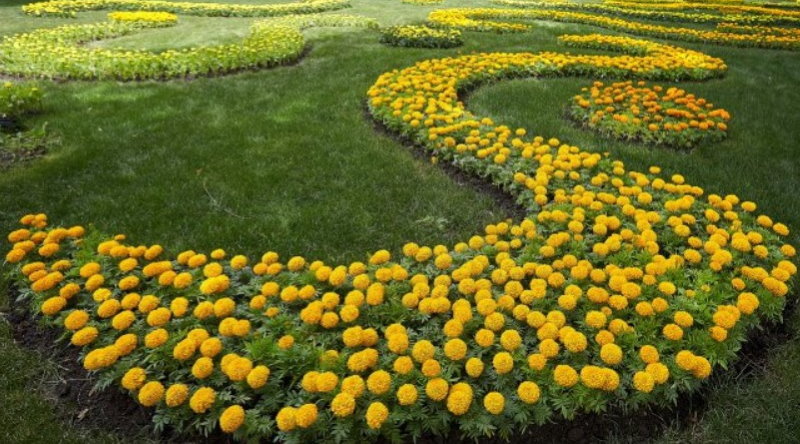
Meandering "track" of low marigold
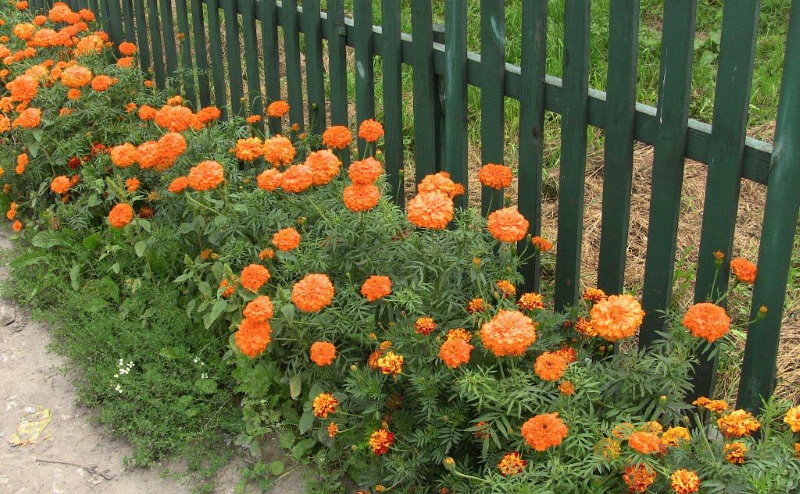
High marigolds along the wooden picket
The number and shape of petals buds:
- gvozdikotsvetnye - have a tongue configuration;
- hrizantemnye - tubular, large;
- anemone, combination of the two previous ones.
Distinguish the following types of marigold flowers:
- Rejected or French. Small height (from 15 to 60 cm) perennial has a two- or three-colored flower buds, dark green foliage. Blooms from June to September, the flowering peak at the end of August.
- Erect, called African. This branching bushes varying in height from 40 to 110 cm, with unpaired leaves jagged shape. Simple or double petals, usually monochromatic. Inflorescences large, 5-15 cm in diameter. Period of life marigolds on the flowerbed - from July to mid-autumn.
- Fine leaved species form low, no more than half a meter, with small bushes dissected leaves. Flowers small size - from 1 to 3 cm, - bezels often have a different shade at the edges. These plants are pleased with its beauty the longest - from early June until frost.
Using marigold in landscape design
They do not require special care (the only condition - good lighting beds), easy to tolerate transplantation, even in the presence of buds.

Rule "earlier planted, early bloom" is well suited for marigolds. Therefore, experienced gardeners grow them through seedlings
Marigolds are used:
- a paint blotches;
- to add contrasts;
- when reaching effect of lace;
- to mask the shortcomings of wilted plants in the flowerbed;
- they are surrounded by beautiful tall perennials and shrubs;
- as an aggregate of voids;
- as an auxiliary focus;
- to decorate the park trails and playgrounds.
Marigold flowers - universal Letnik, so look good on lawns, perfectly fit into the classic curtain garden design, a variety of mixborders, and patterned carpet. They can be used in landscape design based on past projects of modern type, historical simulations, they are useful when implementing a lush flower beds or minimalist decor images.
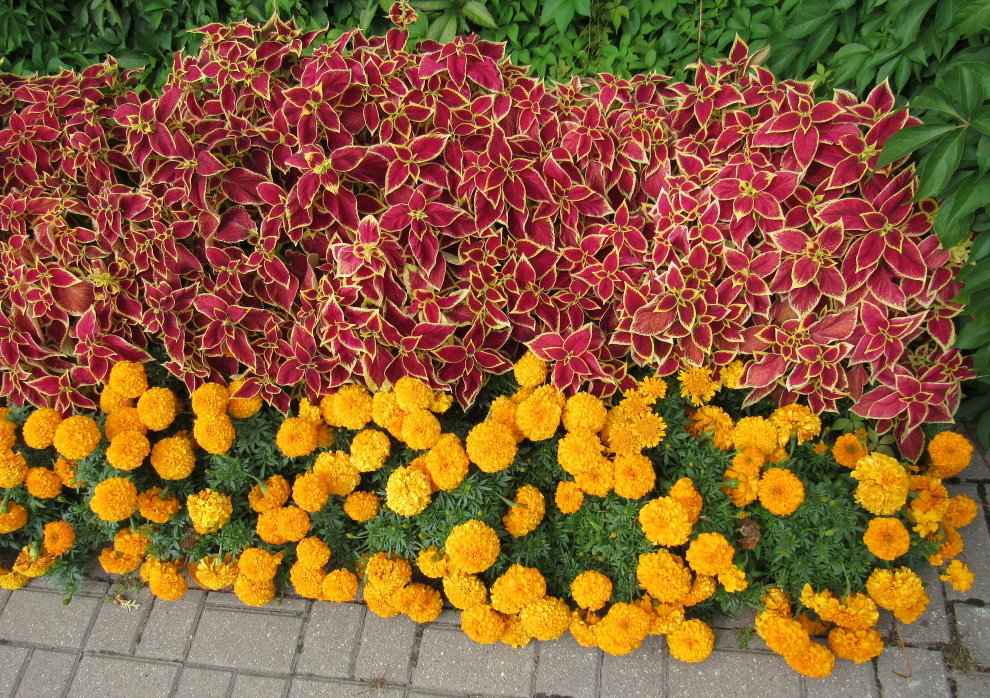
Beds are made up of different varieties of marigold or combined with other ornamental plants
Create a flower garden marigold simple geometric form is the best option for beginners florist. Plants with large buds during landing not less than 25 cm create form a continuous coating. Supplement monochrome planting shade will contrast the variety and originality in the landscape design.
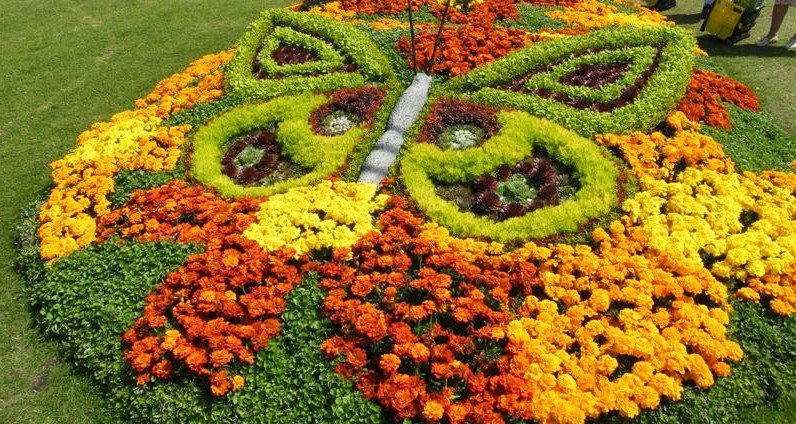
Using marigolds contrasting colors, you can create different patterns on beds
It would seem that for the Japanese rock garden marigolds, photos of flowers in the flower bed are presented in the photo gallery, are not suitable. But colorful asymmetrical inclusion set off the beauty of the harsh rocky landscape.
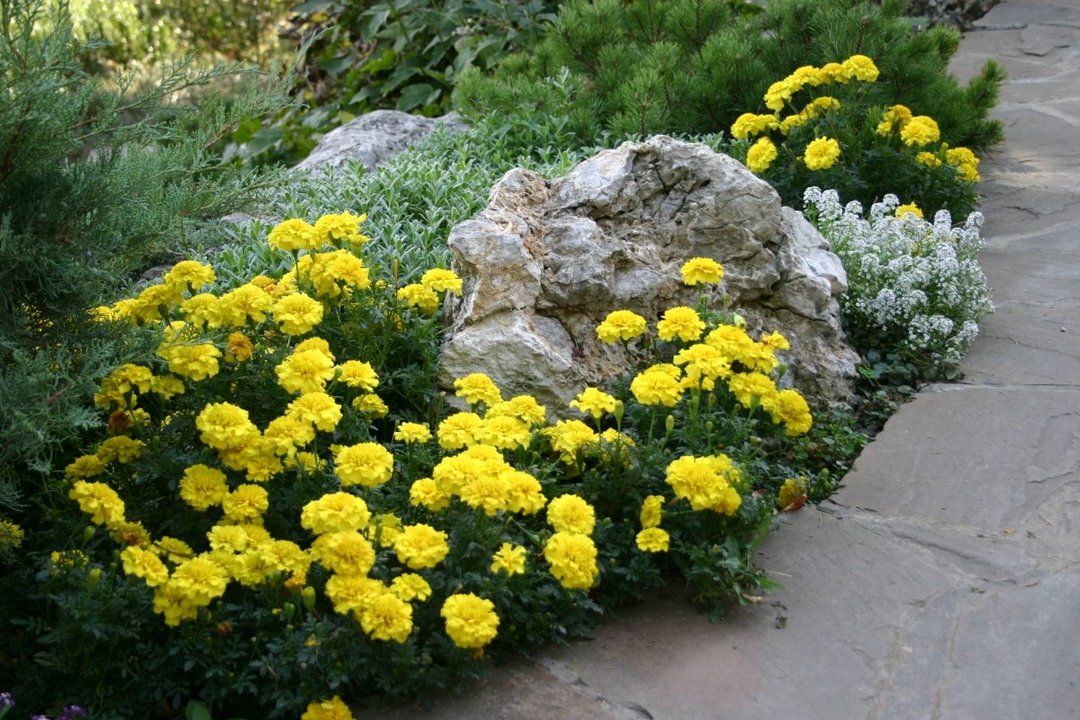
Bright colors can effectively fill the space between the rocks on the alpine hill
In a natural and unforced English Court will tagetis sunny mood. Italian park, so raduyuschemu riot of colors, elegant look of these plants will add originality. Toward Country Sweet William - not just an element of landscape design: it revitalizes the soil and volatile allocated roots, protect against mold and roundworms.
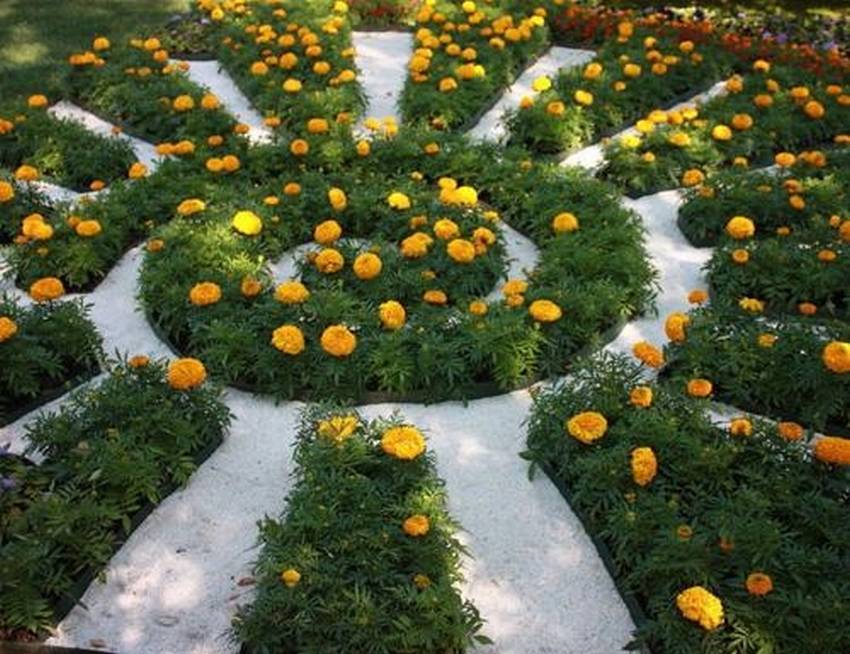
The original composition of the flowering marigold able to decorate the garden any style
Marigolds fine take root in containers. Flowers have excellent stamina, decorate their buds installations large and small, growing indoors.
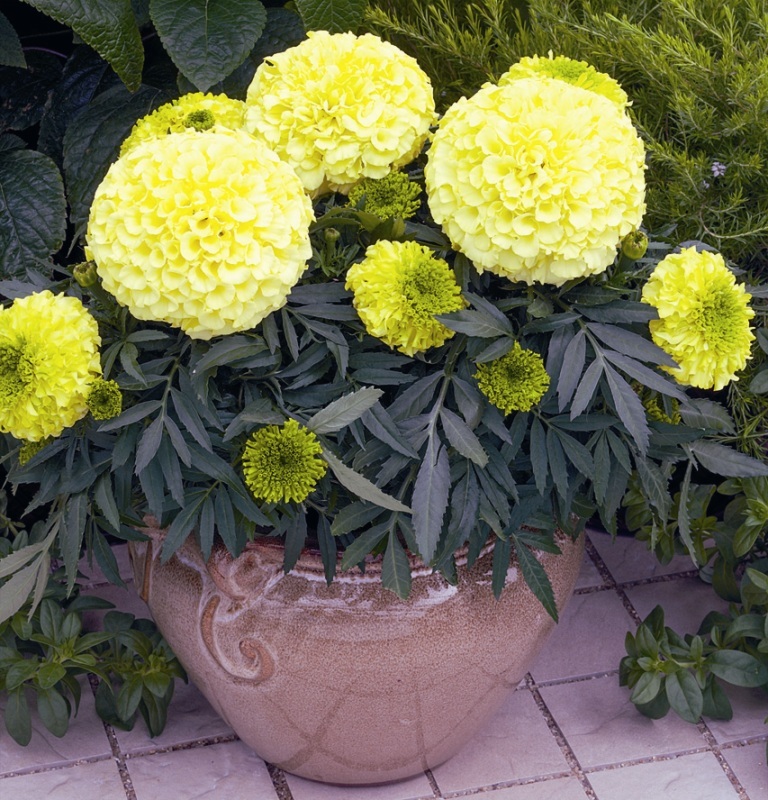
Marigolds thrive in pots, containers or in stone Flower Girl
Effectively looks composition consisting of multiple beds, wherein each planted with plants of the same species of the same color and height. They can be positioned both on the same level and stage. Be sure to use marigolds in the garden, photo and design confirm the need to use them to create a landscape design of any complexity.

Mono-bed is made up of one or more varieties of marigold
Mixborders (in English the "mixed border") - the connection of different groups of flora in the composition, thoughtful harmony of colors and the order of blossoming.
The combination of marigold with other colors
There are some nuances by combining a variety of species and varieties of plants, otherwise the result will not please:
- For a comfortable growth and development need to be carefully selected components beds - with the same lighting requirements, the composition of the soil and the frequency of watering.
- It is important to consider the size and shape of the flowers do not interfere with each other - not shaded and does not harm the root system.
- To know when will be the most magnificent blooming buds.
- Do not forget about the colors of, composing a combination of landscape design. It is advisable to avoid annoying or boring medley of options.
Great idea - the composition of the plants, changing the decorative qualities, depending on the time of day. Some flowers will be disclosed under the bright sun, the other - in the evening or in cloudy weather. Then the multi-colored pattern will change the appearance of several times per day. Tagetes live well on a bed with any of flora - asters, petunias, phlox, sage, viola, dahlias. It should not be planted near roses - "Queen" will not tolerate such a neighborhood. It is also better to refrain from planting in the garden next to the beans, peas and radishes.
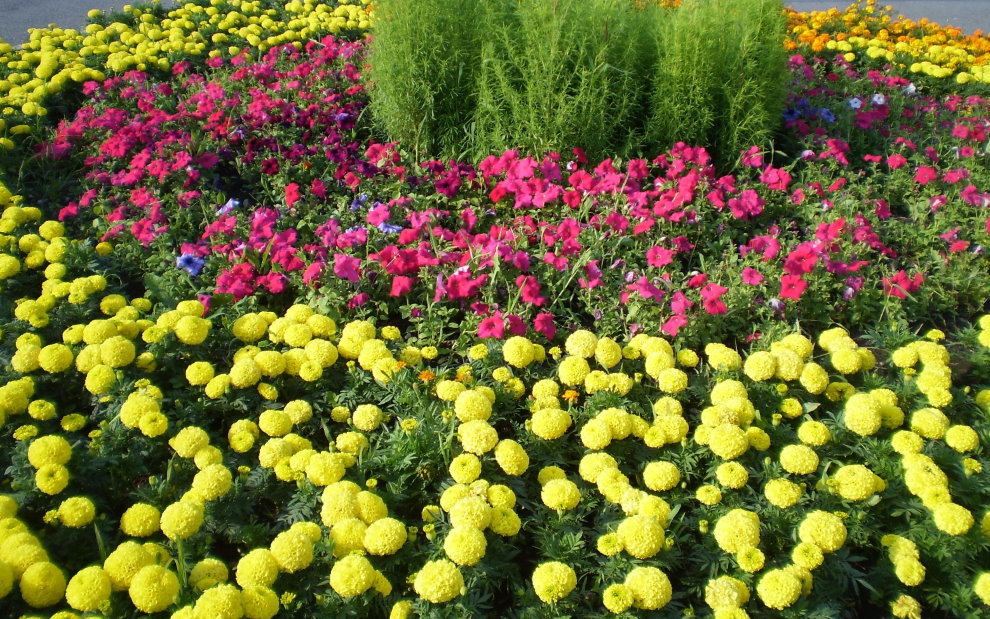
It looks good bed with a ring of marigolds and petunias, in the center of which grow green bushes Kohei

When planting is necessary to consider the joint plant height
With a little work and show imagination, you will get excellent results as in the photo marigold, and the presence of other flowers in the flowerbed will be a pleasant memory of the past summer.
Tips and advice on registration of landscape design
Caring for Marigolds - a pleasure. They will delight lush flowering buds with the minimum maintenance.
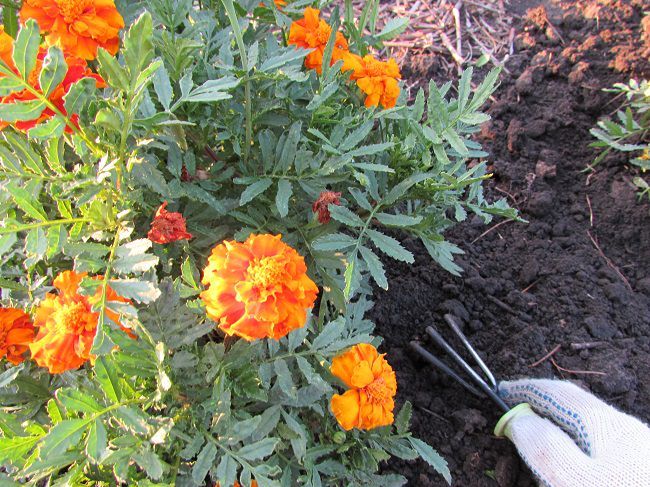
Young marigolds need periodic watering and loosening the soil under the bushes
Terms of care:
- Although suitable for efficient growth of any illumination portion, the bushes will be most interesting on the sunny side beds.
- Regular watering is not mandatory, because the plant drought-resistant, but suffers the shortage of water outside - the lower leaves withered. The overflow will cause stagnation of moisture and rot the roots and stem.
- Fertilizing is generally not required, but if you want to conduct it must be step by step. The first time - upon reaching desyatisantimetrovyh length of a flower, the second - after appearance of flower buds, and third - in the beginning of flowering. Especially important to fertilize marigolds growing in greenhouses.
- To root system to "breathe", it should be more often loosen the soil in the flowerbed a small spatula or a cultivator.
- If the bush is too cumbersome or would like to give it an interesting shape for landscaping, pruning can be carried out, which will update and activates growth.
- Remove wilted marigold buds, avoiding the appearance of bolls. Maturation of the plants require large resources, and it will negatively affect the appearance of the flower beds.
- In the rainy summer, when good breeding slugs and snails need to look particularly carefully. These pests, pull fragrant juices from the buds, discourages the smell of chlorine, tanks which are arranged among the flowers by changing the content on a regular basis. It needs frequent loosening the soil to provide ventilation to the roots.
- marigold planting may be affected by botrytis, which in a few days will turn a luxurious bed in a pitiful sight. This requires drastic measures. The affected plants should be uprooted and quickly destroy by combustion in the fire.
- In dry days can be the risk of spider mites. To deal with it is used frequent spraying with water. If the moment is missed - among the leaves and buds on a bed to stretch the web, the infusion of yarrow mix, onion and chili will eliminate the pest.
- The most common disease of marigold - blackleg, affecting increasingly younger flowers. On the lower part of the stem there is a white film which becomes darker and then rots. This can result in death of the plant. To avoid trouble, you should treat the seeds before sowing and soil fungicide in the garden, observing measure.
Nothing daunting when cultured Chernobrivtsev not. Their aesthetic appearance, which is combined with a practical benefit, attracting the attention of gardeners and florists. Try to create a spectacular thicket of these colors, a good option for home decorating can look at the photos of marigold buds in landscape design suburban area.



